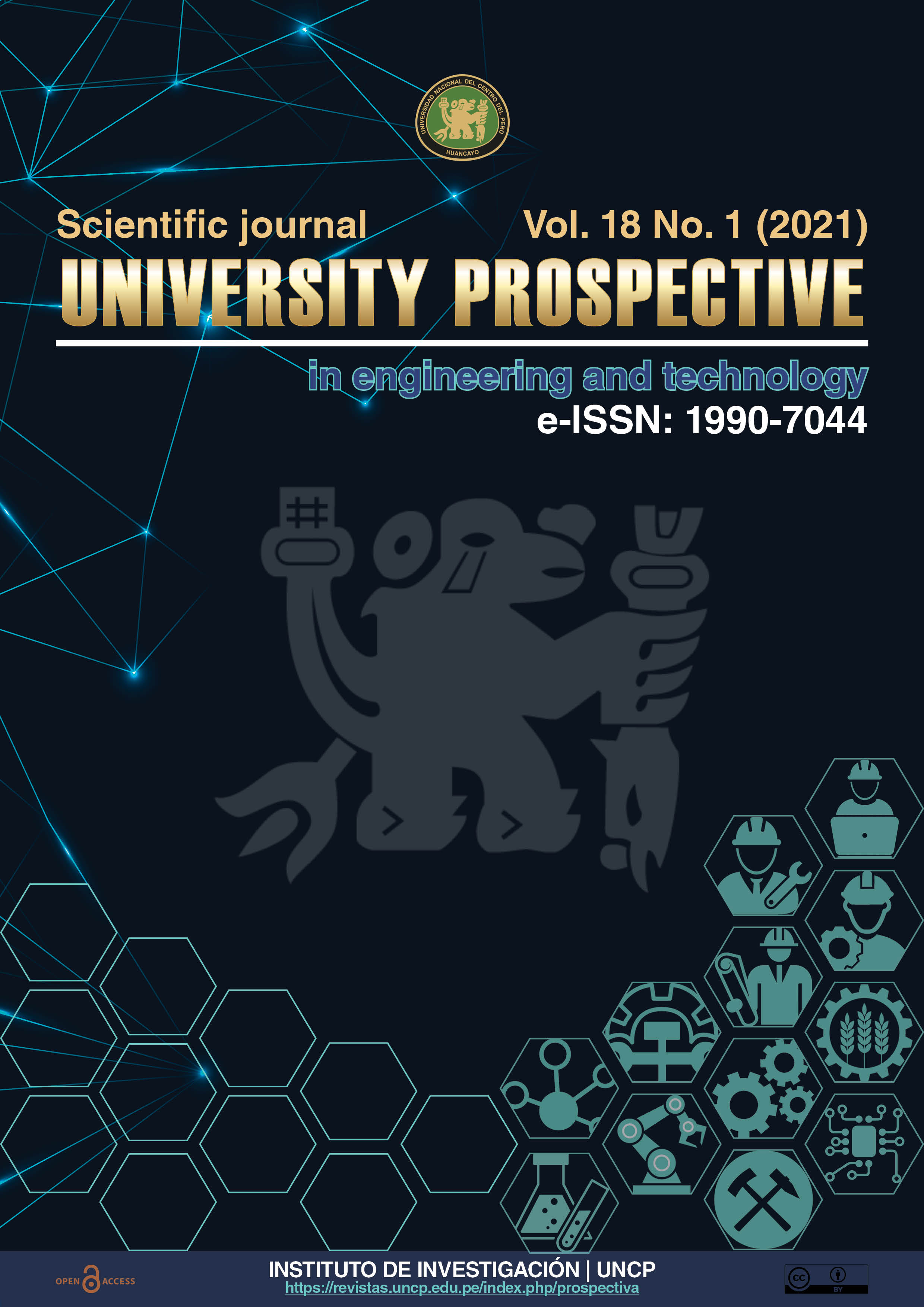Performance Analysis of UNCP 3.25 kWp PV System and traditional modeling methods in Huancayo – Perú
DOI:
https://doi.org/10.26490/uncp.prospectivauniversitaria.2021.18.1651Keywords:
Energía solar, Sistema fotovoltaico, Estudio de desempeño, Producción energética, Suministro eléctrico, Huella de carbonoAbstract
In 2018, Peru's Ministry of Energy and Mines (MEM), with support from the United Nations Development Program (UNDP), installed 3.25 kW photovoltaic systems in its infrastructures in different parts of Peru, with one of the selected locations being those of the UNCP. Therefore, this research aimed to determine the performance of the photovoltaic system installed in the environments of the Faculty of Electrical and Electronic Engineering of the UNCP in the city of Huancayo with respect to conventional calculation models. Taking into account that, this photovoltaic system operates in the middle of the central Andes of Peru at an altitude above 3,200 meters above sea level. The energy production data for one year has been analyzed and compared with the results of theoretical calculations, in order to introduce improvements to the calculation models for future photovoltaic systems that are designed and built in this region considering climatic, technical and economic conditions. The methodology used has a descriptive-correlational scope, with a collection of quantitative data from the system's energy production records, use of historical solar radiation data and a correlational statistical analysis using the Pearson correlation coefficient using specialized software. The results showed that the adjustments proposed for traditional methods improve the calculation of energy production, making the calculated values adjust to the real ones.Palabras clave: informática educativa, materiales educativos, estudiante universitario, material didáctico
Downloads
References
Gow, J. A. & Manning, C. D. (1996). Development of a model for photovoltaic arrays suitable for use in simulation studies of solar energy conversion systems. Sixth International Conference on Power Electronics and Variable Speed Drives (Conf. Publ. No. 429), 1996, pp. 69-74, doi: 10.1049/cp:19960890
Vera Dávila, A. G.; Delgado Ariza, J. C. & Sepúlveda Mora, S. B. (2018). Validación del modelo matemático de un panel solar empleando la herramienta Simulink de Matlab. Rev.investig.desarro.innov, 8(2), 343-356.
Jiménez, L.; López Aguayo, F. & Sales D. (2007). Manual del máster en Gestión en Energías Renovables. Tomo VI. Energía solar fotovoltaica. FUECA, Universidad de Cádiz.
Fiallos, D. & Tipán, L. (2020). Determinación del punto óptimo de potencia de paneles fotovoltaicos en base a variables difusas mediante el modelo de Liu Jordan. Universidad Politécnica Salesiana de Quito.
Ahmadzai, S. & Varshney, L., (2021). Performance Improvement of Solar PV Under Partial Shading Conditions. International Conference on Intelligent Technologies (CONIT), pp. 1-5, doi: 10.1109/ CONIT51480.2021.9498408.
Das, S.; Namrata, K. & Ray, P. (2021). Dual model representation of solar photovoltaic cell. International Journal of Emerging Electric Power Systems, 20210042. https://doi.org/10.1515/ ijeeps-2021-0042
D'Angles, B. (2020). Análisis de los factores que influyen en el diseño de una planta fotovoltaica de 40MW ubicada en el valle del Mantaro [Tesis, Universidad Nacional del Centro del Perú]. http://hdl.handle.net/20.500.12894/6031
Lemes, Francisco R.; Cari, Elmer P.T. & Corrêa, Vitor A. (2019). Parameter Estimation of Photovoltaic System Using Real Condition Data. IEEE Canadian Conference of Electrical and Computer Engineering (CCECE)
E.Kumar, Madhav / D. V. Shiva Krishna Rao, K. (2019). Modelling and Parameter Estimation of Solar Cell using Genetic Algorithm
Diario Gestión. (2016). MEM lanza proyecto para promover la reducción de emisiones de gases de efecto invernadero. Publicación en línea. https://gestion. pe/economia/mem-lanza-proyecto-promover-reduccion-emisiones-gases-efecto-invernadero-118567-noticia/
Vergara Carranza, K.; Piedra Segura, J. & Richmond Navarro, J. F. (2018). Dimensionamiento de sistemas fotovoltaicos mediante una interfaz gráfica. Tecnología en Marcha. Vol. 32-3. Julio-Setiembre 2019. Pág. 66-78
Downloads
Published
Issue
Section
License
Copyright (c) 2021 Boris Ernesto D’Angles Woolcott

This work is licensed under a Creative Commons Attribution-NonCommercial-ShareAlike 4.0 International License.
Esta Revista es de acceso abierto a su contenido a través del Internet, poniendo a disposición de la comunidad científica los resultados de la investigación, de manera gratuita, para el intercambio del conocimiento desarrollado.
El contenidos de la Revista se distribuyen bajo la licencia Creative Commons Reconocimiento-NoComercial-CompartirIgual 4.0 Internacional.
![IconJournalPU [ENG] by Edgar Julian-Laime®](https://revistas.uncp.edu.pe/public/journals/1/pageHeaderLogoImage_en.png)









